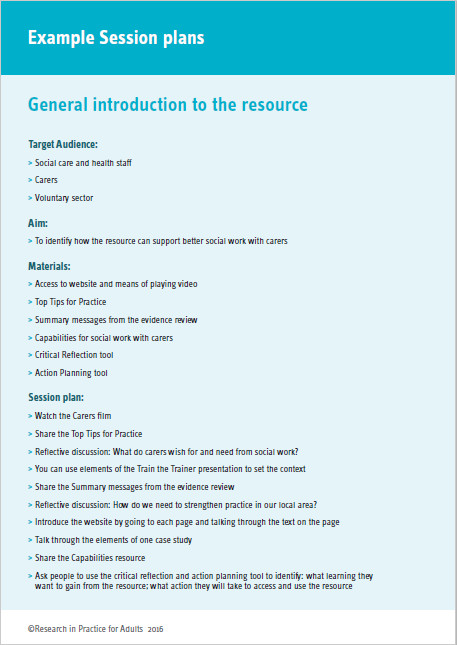Contents
Example session plan
Example session plan
General introduction to the resource
Target Audience:
- Social care and health staff
- Carers
- Voluntary sector
Aim:
- To identify how the resource can support better social work with carers
Materials:
- Access to website and means of playing video
- Top Tips for Practice
- Summary messages from the evidence review
- Capabilities for social work with carers
- Critical Reflection tool
- Action Planning tool
Session plan:
- Watch the Carers film
- Share the Top Tips for Practice
- Reflective discussion: What do carers wish for and need from social work?
- You can use elements of the Train the Trainer presentation to set the context
- Share the Summary messages from the evidence review
- Reflective discussion: How do we need to strengthen practice in our local area?
- Introduce the website by going to each page and talking through the text on the page
- Talk through the elements of one case study
- Share the Capabilities resource
- Ask people to use the critical reflection and action planning tool to identify: what learning they
want to gain from the resource; what action they will take to access and use the resource
General introduction to any case study
General introduction to any case study
Target Audience:
- Any group
Aim:
- To give an initial understanding of any of the case studies (you can then use a more specific session plan)
Materials:
- Access to website and means of playing audio
- Whole case study document for one of the case studies
- One-page profile template
- Ecogram template
- Support plan template
- Critical reflection tool
- Action planning tool
Session plan:
- Introduce the website and the case studies section by using the text on the welcome page
- Go to one of the case studies and play the audio
- Reflective discussion: What are some of the implications for social work with this person/ these people?
- Share the vignette and chronology; ask small groups to complete the one-page profile and ecogram;
then compare with the worked examples - Share the assessment; ask small groups to complete the support plan; then compare with the worked
example - Introduce the topics and tools for the case study by talking through these on the website
- At the end of any session, use the Critical Reflection tool and Action Planning tool to identify learning
and how this will be used in practice
Case study 1: Eve
Case Study 1: Eve
Target Audience:
- Social workers
Pre-course preparation:
- Ask participants to look at the vignette, ecogram and chronology for Case Study 1
Handouts:
- Vignette
- Case study 1: Tool 2 Family group conferences
Session plan (one hour):
- In pairs discuss experiences of services that have been good or bad (10 mins)
- Small group work: Look at the vignette for Eve and identify what will be important to her, Matt,
Geoff and Joanne in terms of how you work with them – each group takes a different person (10
mins) - Feedback as a group on what is important to each person (15 mins)
- Small group work: use the Family group conferences tool to write a statement for stage 3 –
information giving (20 mins) - Close the session by asking people how they might use family group conferences in their work (5
mins)
Case study 2: Josef
Case study 2: Josef
Target Audience:
- Carers team or transitions team
Pre-course preparation:
- Ask participants to look at the vignette, ecogram and chronology for Case Study 2
Materials:
- Assessment
- Case study 2: Tool 5 Family model for assessment
- Case study 2: Tool 6 Engaging young carers
Session plan (one hour):
- Listen to the audio for Josef (5 mins)
- Small group work: use the vignette and assessment to complete the Family model tool (25 mins)
- Feedback (15 mins)
- As a whole group look at the Engaging young carers tool
- Reflective discussion: how can we engage young carers better? (10 mins)
- Finish by identifying next steps to develop practice (5 mins)
Case study 3: Susan
Case study 3: Susan
Target Audience:
- Social Care Teams including social workers, social care workers and OTs
Pre-course preparation:
- Ask participants to look at the vignette, ecogram and chronology for Case Study 3
Materials:
- One-page profile template
- Support plan template
Session plan (one hour):
- Go to the ‘Topics’ section of Case Study 3 and find the section on ‘Identity and sexuality’. Watch the SCIE
video:
Working with lesbian, gay, bisexual and transgendered people: older people and residential care:
Roger’s story (10 mins) - Now tune back in to Susan’s story by listening to the audio of Susan (5 mins)
- In pairs complete a ‘One page profile’ of Susan, using the first person ‘I’ (10 mins)
- Small group discussion: What are the key issues for Susan? (10 mins)
- Feedback from small groups and capture on flip chart (5 mins)
- Small group work: each group pick one topic (for example: finance/property; transition issues; LGBT
issues; Susan in ‘non-caring’ role; family conflict). In relation to your chosen topic – using the blank - Support plan, turn needs into outcomes and identify actions required (include by whom and by when),
signposting wherever possible to resources available in your locality (15 mins) - Finally, browse the tools in relation to Case Study 3 and if you have time look at the tools
Case study 4: Anne
Case study 4: Anne
Target Audience:
- Social Care Teams – Older People
Pre-course preparation:
- Ask participants to do a learning needs analysis of their CPD in supporting families through the end
of life of a loved one (Case Study 4, Tool 2: Learning needs analysis for social workers for end of life
care)
Materials:
- Whole case study document for Case Study 4; Ecogram template
- Support plan template
- Case study 4: Tool 4 – Supporting older carers, spheres of support
Session plan (one hour):
- Read the vignette and listen to the audio of Anne (5 mins)
- Individually read the chronology and complete the Ecogram (5 mins)
- In pairs discuss your existing strengths in working with Anne (10 mins)
- Now read the Carers Assessment and look at Tool 4 – Supporting older carers, spheres of support (5
mins) - Small group work: develop a Support Plan (using the blank template) turning needs into outcomes
and identify actions which signpost to resources available in your locality (20 mins) - Finally as a group look at Tools 3 and 6 from Case Study 4 – might you use either of these in your
work with Anne and if so how? Are there Tools from other case studies you might use to support your
work with Anne? (15 mins)
Case study 5: Michelle and Joel
Case study 5: Michelle and Joel
Target Audience:
- Learning Disability Teams
Pre-course preparation:
- Ask participants to look at the vignette, ecogram and chronology for Case Study 5
Handouts:
- One-page profile template
- Support plan template
Session plan (one hour):
- Small group work: listen to the audio of Michelle and Joel (5 mins)
- Two of the group adopt the role of Michelle and Joel and are asked questions by two other members
of the group who are undertaking a joint assessment as part of the carers’ assessment and
support planning process (10 mins) - The rest of the group observe and make notes on how to turn needs into outcomes
- Observers give feedback to the assessors on turning needs into outcomes (10 mins)
- The two assessors now have a further conversation with Michelle and Joel to identify their specific
personalised outcomes and record these using the One-page profile (one for Michelle and one for
Joel) (15 mins) - The role play part of the session now ends and the whole group work together on drawing up a
- Support Plan for Michelle and Joel’s situation locally (i.e. one Support Plan for the couple which
maps to local resources in your own area). Remember to include actions to promote risk enablement
– see Case Study 5, Topics Risk enablement and independence, and Tools 3 & 4 (20 mins)
Themes for sessions
Themes for sessions
You can run sessions on the following themes using topics and tools from different case studies:
Transition
- Case study 2: Young carers; Tool 3 Young carers’ rights
- Case study 3: Transitions for carers, Transition into a care home; Tool 1 Carer life transitions
- Case study 4: End of life; Tool 3 Starting the conversion
- Case study 5: Older family carers; Tools 5 and 6 Planning
Whole family approach
- Case study 1: Life course and whole family approaches; Tool 2 Family group conferences
- Case study 2: Young carers of parents with mental health problems; Tool 5 Family model of assessment
- Case study 3: Family complexity and conflict; Tool 2 Mediation stages
- Case study 5: Attachment; Tool 2 Social work capabilities for attachment-aware practice
Choice and control
- Case study 2: Mental capacity, confidentiality and consent; Tool2 Capacity tool
- Case study 5: Risk enablement and independence; Tool 3 Risk enablement
Equality and diversity
- Case study 3: Identity and sexuality; Tool 5 Top tips for including LGBT people
- Case study 4: Religion and spirituality; Tool 6 Principles for reflection on religion and beliefs
- Case study 5: Ethnicity and culture and language; Tool 7 Culturally competent planning
Joint work with health
- Case study 1: Dementia; Tool 4 Triangle of care – dementia
- Case study 2: Mental health; Tool 1 Triangle of care – mental health
- Case study 4: End of life; Tool 1 What social workers offer at end of life
Inclusion
- Case study 1: Carers’ employment; Tool 1 Support for carers in employment
- Case study 2: Young carers and education/ employment; Tool 3 Young carers’ rights
- Case study 4: Social isolation; Tool 4 Spheres of support









